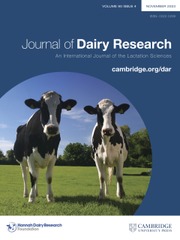No CrossRef data available.
Article contents
Immunoglobulin concentration in bovine colostrum obtained by indirect methods
Published online by Cambridge University Press: 20 November 2025
Abstract
The quality of colostrum is essential for the successful transfer of passive immunity and the early development of the immune system in newborns. This research was conducted with the aim of evaluating the agreement between measurements from different equipment: colostrometer, digital Brix refractometer and optical Brix refractometer, using fresh colostrum samples maintained at 21°C. Colostrum samples were collected from two farms (n1 = 31 and n2 = 193). Farm 1 included females from second to ninth lactation, comprising 15 Holstein Friesian (HF), 5 Jersey and 11 Holstein × Jersey crossbreeds. Farm 2 had HF heifers and cows from first to seventh lactation. Immunoglobulin content was assessed indirectly with a colostrometer and both types of Brix refractometers (digital and optical). For the correlation analysis, Pearson's product-moment method was used to assess the linear association between the equipment, followed by a Student's t-test and comparison of the obtained values with specific correlation coefficients (50%, 70%, 90% and 99%). There was a 98% correlation between the refractometers on Farm 1, which was significantly higher (P < 0.0001) than the commonly used reference values for weak (50%), moderate (70%) and strong (90%) correlations, and statistically equivalent to a 99% correlation. This indicates a very high, positive linear association between the digital and optical Brix refractometers. On Farm 2, a 97% correlation was found between the refractometers, which was significantly higher (P < 0.0001) than the specific reference values of 50%, 70% and 90%, but significantly lower than a 99% correlation.
Information
- Type
- Research Article
- Information
- Copyright
- © The Author(s), 2025. Published by Cambridge University Press on behalf of Hannah Dairy Research Foundation.

